Woody encroachment
Over the last 150 years, and the last 50 years in particular, woody plants have expanded into long-standing grasslands and savannas on every continent except Antarctica—a phenomenon known as woody encroachment (or bush encrochment in the southern hemisphere). Woody encroachment has a negative impact on plant diversity in North America and in some cases, leads to desertification.
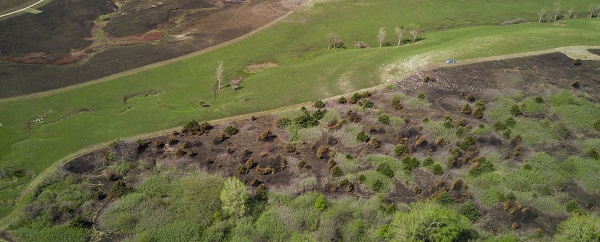
Infrequent (> 3 yrs) burn frequencies at Konza Prairie have resulted in mosaics of woody plants.
We’re studying how internal dynamics of shrub-grass competition interact with the external forcing of global change, to understand woody-grass competition in general, and how the balance of woody plants vs. grasses will change in the future. To guide our research, we use a conceptual framework built from aspects of theoretical savanna ecology, stable-state theory, and coexistence theory. We’re applying these perspectives to a diverse group of data-types, including long-term data-sets of grass/shrub cover, physiological measurements of plant form and function, and vital rates of shrubs (i.e. demography).
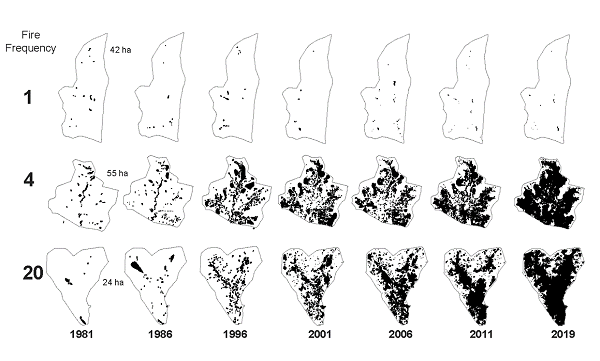
Fire frequency drives woody encroachment at Konza. Top row: watershed 1D is burned each year, with almost no increase in woody cover since 1981. Conversely, infrequet fire (every 4 years - middle row, and every 20 years - bottom row) results in widespread increases in woody cover.
Our lab has many ongoing proejcts focused on the woody encroachment of prairie and savanna. You can find more information on ShRaMPs or how woody encroachment impacts a ecohydrology by visiting those research pages.
The links below will provide more details on a variety of other current projects focused on woody encroachment in the ecophys lab.
- Resilience and ecological theory
- LAI and canopy density
- Above ground traits of woody encroachers
- Root excavations
- BNPP and root distributions
- Root traits
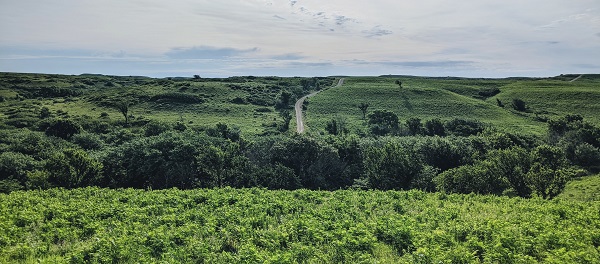
Woody Konza: Sumac in the foreground, oaks in the middle, and dogwood on the horizon (photo by R. Keen).
Resilience and ecological theory
We have been very fortunate to work with Dr. Zak Ratajczak to develop ideas of tallgrass prairie resilience - which coincidentally is the theme of Konza Prairie LTER 8! The long-term data collection managed by Konza LTER (species composition and cover) under different fire and grazing treatments have revealed state transitions to shrublands or woodlands following long-term alterations in fire frequency. The identification of these transitions was integral to developing and testing theories describing alternative stable states and tipping points in tallgrass prairie.
For example, we found that the long time lags preceding woody encroachment present a window of opportunity for early management interventions (Ratajczak et al. 2017). This insight led to a new theoretical framework that describes ecological thresholds in terms of both the magnitude and duration of a change in drivers that must be exceeded before state changes become difficult to reverse (Ratajczak et al. 2017).

State transitions on Konza - changes in fire frequency reduce the resilience of the grassy landscape.
Recently, we had the opportunity to work with Zak, Scott Collins, and John Blair using a long term fire reversal experiment on Konza to identify hysteresis. Hysteresis is a fundamental characteristic of alternative stable state theory, yet evidence of hysteresis is rare. In mesic grasslands, fire frequency regulates transition from grass- to shrub-dominated system states. It was uncertain, however, if increasing fire frequency can reverse shrub expansion, or if grass-shrub dynamics exhibit hysteresis. These results demonstrated that annual burning can slow, but not reverse, shrub encroachment. In addition, reversing fire frequencies resulted in hysteresis because vegetation trajectories from grassland to shrubland differed from those of shrubland to grassland.
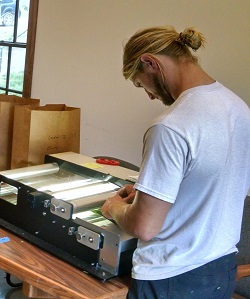
The primary encroaching shrub species at Konza Prairie is rough-leaf dogwood (Cornus drummondi). The high canopy density of this species can reach LAI values of 8-9, and subsequently shade out understory herbaceous plants. This deep canopy results in a change in fire dynamics such that not enough fuel is available to suppress woody plants once established.
Greg Tooley (right) harvested 1 m2 sections from dogwood islands in the summer 2020 in watersheds grazed by bison, ungrazed, and islands that had simulated browsing (to mimic elk consumption). From each location, Greg measured LAI using a Licor LAI meter (LAI2200), scanned each leaf in 10 cm depth increments (using a Licor 3100) to cumulatively determine leaf density and captured changes in canopy density using an EinScan 3D scanner (Pro 2x). This study provides information on changes in canopy density based on landscape grazing/browsing treatments and allows for more direct comparisons of methods for determining LAI in clonal species.
Aboveground traits of Woody Encroachers
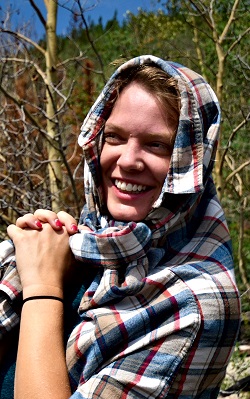
Despite considerable research focused on identifying the drivers and consequences of woody expansion, we have limited understanding of the physiological traits that facilitate the establishment and spread of encroaching shrubs. Research investigating the interspecific variability of traits related to species growth and abundance is needed to understand the mechanisms of woody encroachment and predict future woody cover in grasslands.
Emily Wedel (left) leads this project and has measured traits related to carbon gain and drought tolerance for the seven most dominant encroaching woody species at Konza Prairie. These traits included turgor loss point, woody density, water use efficiency, quantum yield, and leaf functional traits. Together, these traits will give deeper insight into interspecific differences in shrub physiology to assess the strategies each species uses to survive in a fire-prone ecosystem. We will use long-term species cover data from Konza Prairie LTER to investigate if these traits explain species abundance and rates of encroachment on the landscape.
Preliminary results show the species expanding the fastest, Cornus drummondii, has a higher turgor loss point than less abundant species. This result supports our presumption that higher turgor loss point is associated with lower drought tolerance. We will continue these measurements along with measurments of nonstructural carbohydrates in 2022 and 2023.
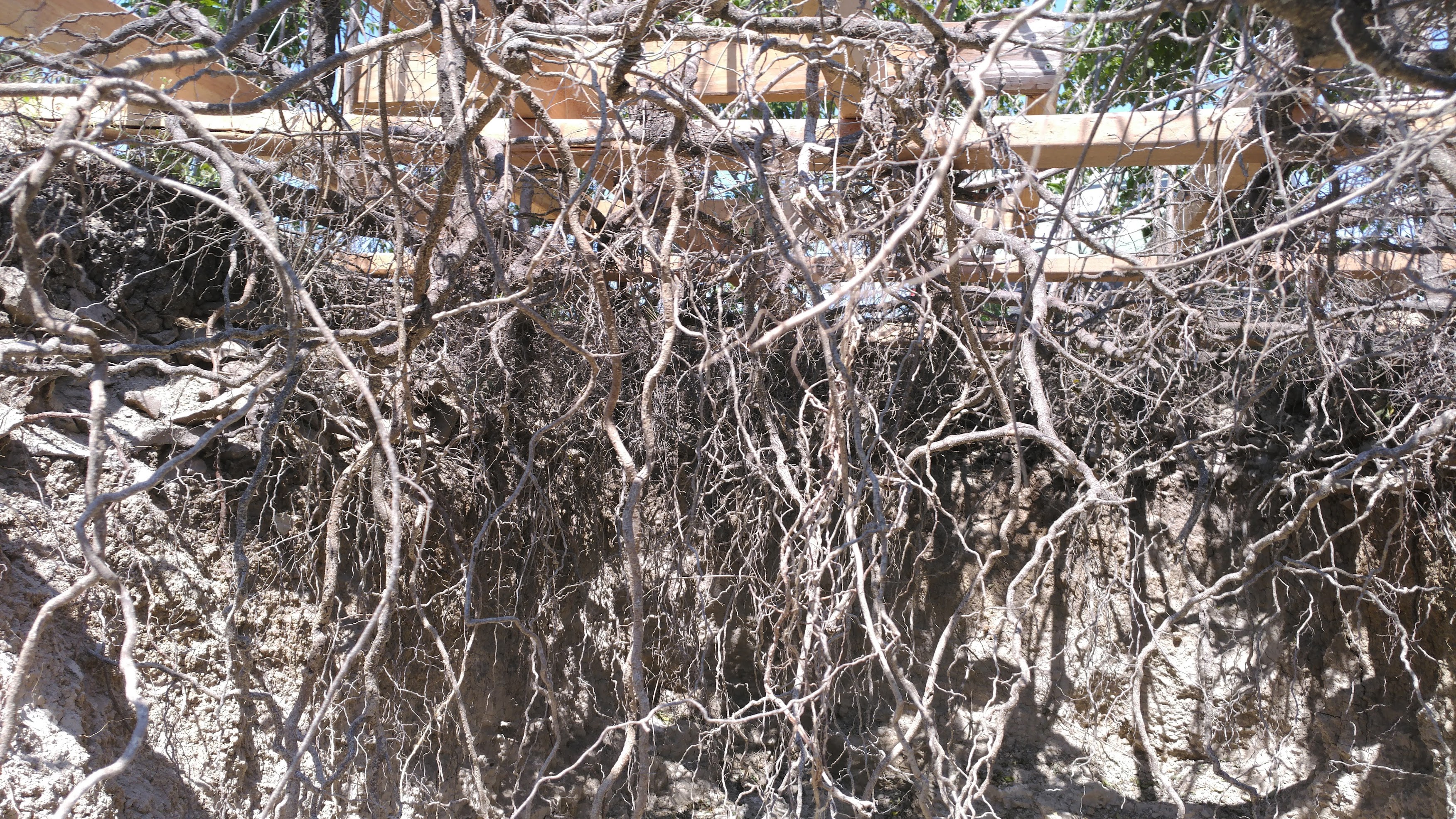
Greg and Anna spent the summer 2021 excavating the root systems of rough-leaf dogwood.
Woody encroachment has received extensive study, but the majority of work has focused aboveground or on the impact in the shallowest surface soils. This is especially problematic for capturing the impact and feedbacks of vegetation change since woody species typically have deeper roots than grasses, so a major impact on changes in C cycling would be expected in the deeper soil layers—far from the depths previously studied.
To describe the root architecture of shrub:grass assemblages in detail, Greg Tooley and Anna Shats excavated entire shrub islands on Konza to 2 m depth using an AirSpade, a compressed air tool that allows for soil excavation leaving roots in place. The method is time-intensive but provides unparalleled belowground data on entire rooting systems. This technique provides tremendous belowground detail into communities, since aboveground tissues remain connected to belowground tissues - facilitating species identification and the establishment of trait linkages below and above-ground. In the summer, 2021, 10 replicates of shrub-grass islands of ~ 16-20 m2 size were excavated in a 4-yr burned watersheds. Results of these excavations will follow!
Extensive data exists to describe aboveground biomass and productivity in grassland ecosystems. In contrast, we know very little about belowground productivity or root biomass at varying soil depths. For the root data that does exist, it is typically constrained to the top 10-20 cm of the soil.
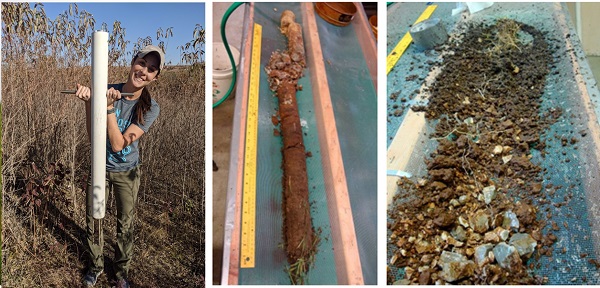
Retrieving 1 m deep soil cores is tough! Here, Rachel goes from extraction, to subdivision to picking roots.
In this project we are measuring the belowground net primary productivity (BNPP) in primarily grassy and woody locations of tallgrass prairie to 1 m depth. This project is conducted by Rachel Keen and Anna Shats. We have BNPP data for 2019-2020, and 2020-2021. Data was collected in 10-cm increments and includes biomass, root C:N, root length distributions, and root size class distributions determined by WinRhizo.
We have assessed how woody and grass root anatomical traits vary among soil depths and different fire frequencies to better understand the water-use strategies exhibited by these two functional groups in tallgrass prairie. Specifically, we addressed the following questions: (1) Do grass and woody root anatomical traits differ with fire frequency or soil depth? (2) Do relationships between anatomical traits that confer hydraulic safety versus efficiency vary by fire frequency or soil depth? (3) Is root anatomy associated with integrative root traits (e.g., root diameter, SRL, and root biomass)?

This project is led by Kim O'Keefe, and supported by Rachel Keen, Seton Bachle, and Greg Tooley. Here, we collected grass and woody roots from 10, 30, and 50 cm deep soil in areas burned every 1, 4, and 20-years and measured xylem conduit diameter, conduit cell wall thickness, conduit number, conduit mechanical safety (t/b), stele area, endoderm thickness, hydraulic diameter, theoretical hydraulic conductivity, and theoretical hydraulic conductance. The results so far show that woody roots had high hydraulic conductance in shallow soils and greater mechanical strength in deeper soils, which may provide a competitive advantage in less frequently burned, more diverse plant communities. Shallow grass roots had unique trait combinations at the anatomical and root-system levels (thinner, more numerous conduits and higher hydraulic conductance compared to deeper roots) that likely allow these plants to rapidly use water but tolerate dry soils under multiple fire regimes. Finally, hydraulic safety versus efficiency tradeoffs may translate between different hierarchical scales (i.e., from anatomical to integrative root traits). These results provide anatomical evidence to explain water-use dynamics in tallgrass prairie and also provide novel insight regarding functional strategies that may facilitate the conversion from grassland to shrubland in less frequently burned tallgrass prairie.
Projects supported by DOE-BER:
Using root and soil traits to forecast woody encroachment dynamics in mesic grassland.
Projects supported by NSF-LTER:
Konza Prairie LTER: Manipulating drivers to assess grassland resilience.
Project PI's:
Dr. Zak Ratajczak (Kansas State University),
Dr. John Blair (Kansas State University),
Dr. Kim O'Keefe (St. Edward's University),
Dr. Kevin Wilcox (University of Wyoming),
Dr. Rory O'Connor (USDA-ARS),
Dr. Seton Bachle (Colorado State University),
Dr. Lydia Zeglin (Kansas State University),
Dr. Jesse Nippert (Kansas State University)
Project Graduate Students:
Greg Tooley (Kansas State University),
Emily Wedel (Kansas State University),
Rachel Keen (Kansas State University)
Anna Shats (Kansas State University)
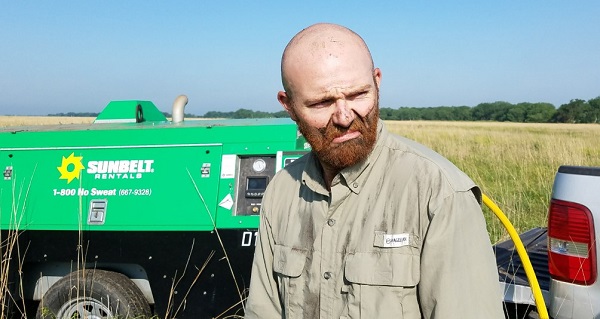
Excaving root systems all day leaves a Seton very dirty and very grumpy.